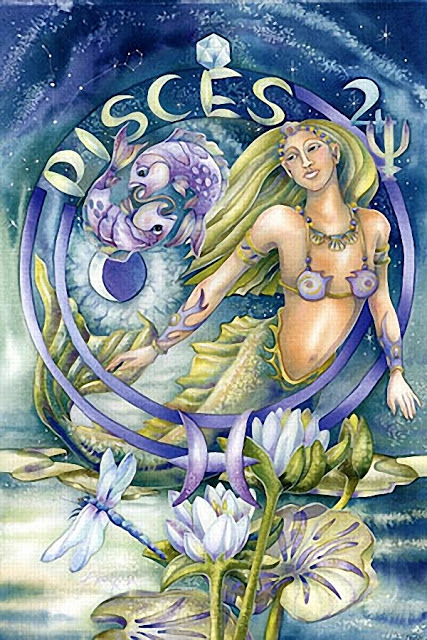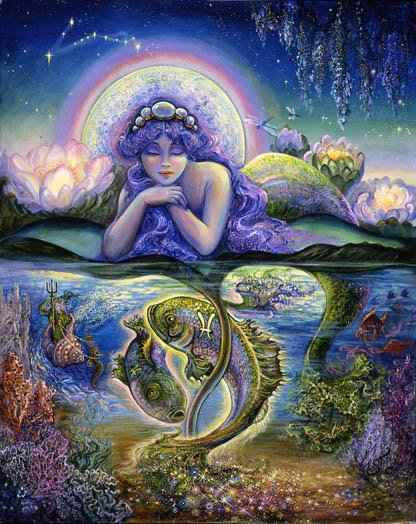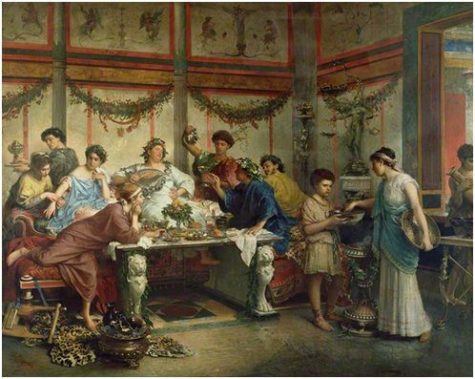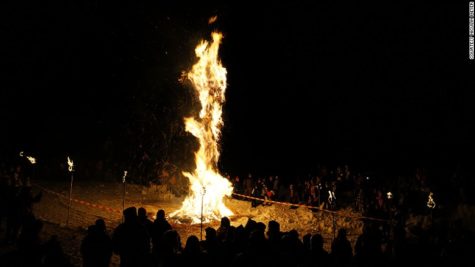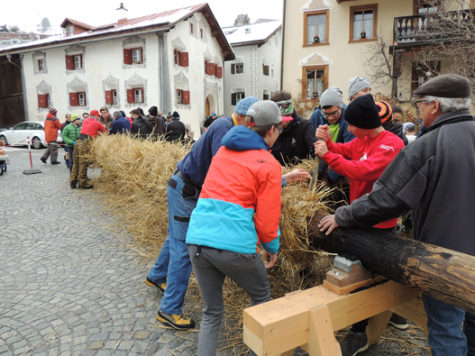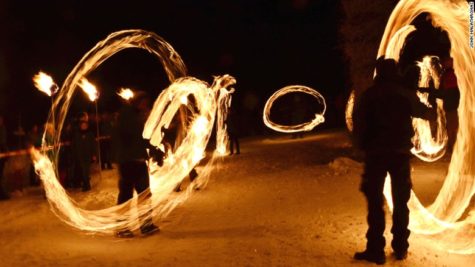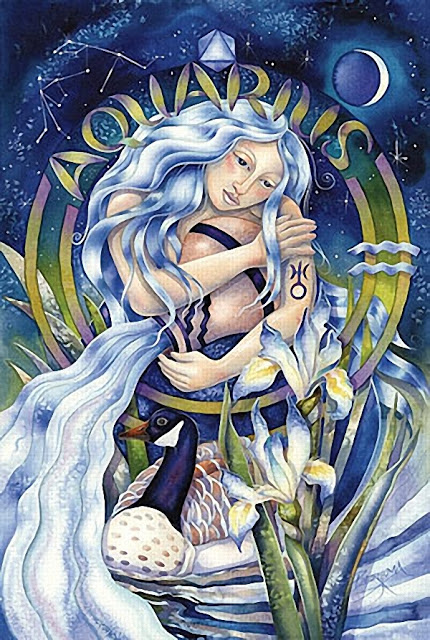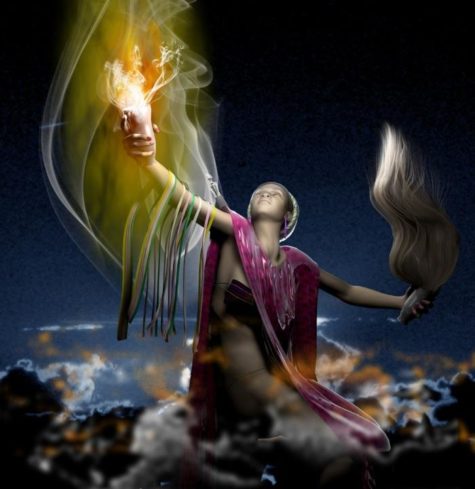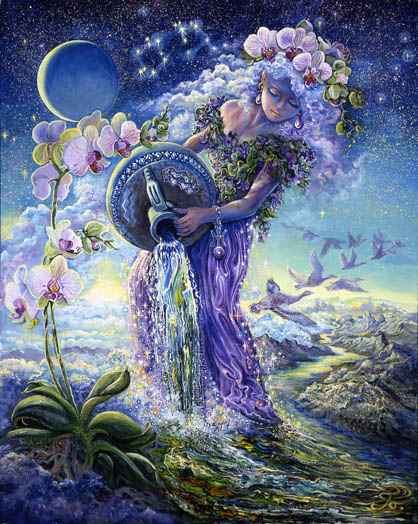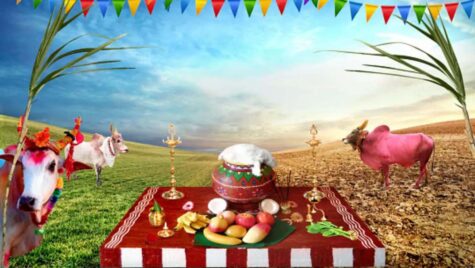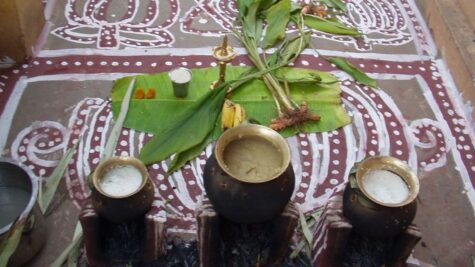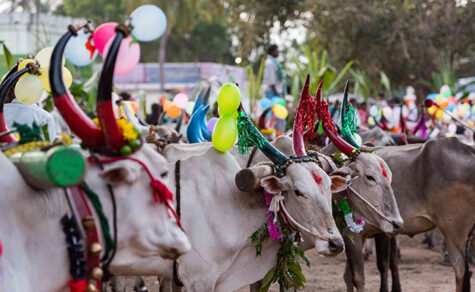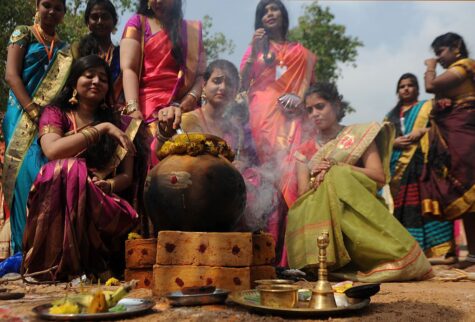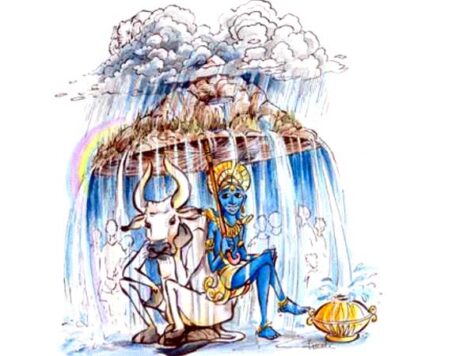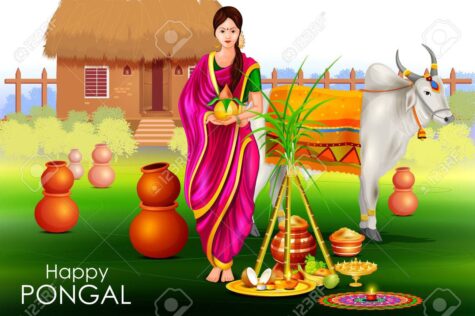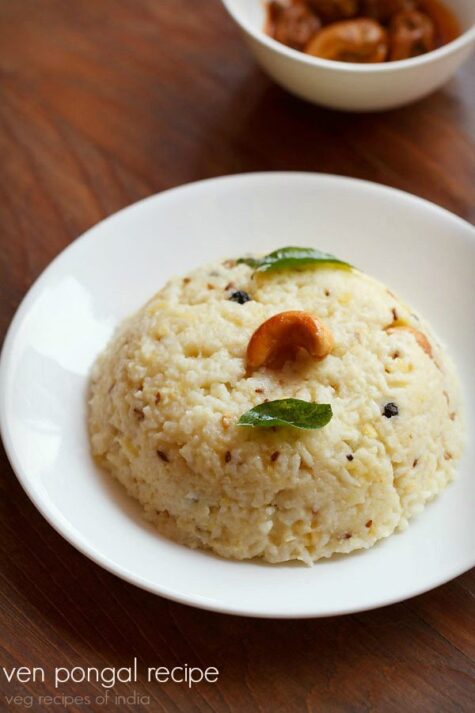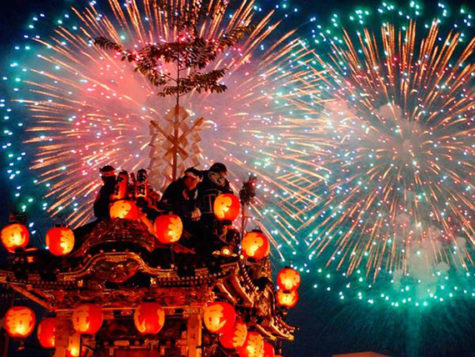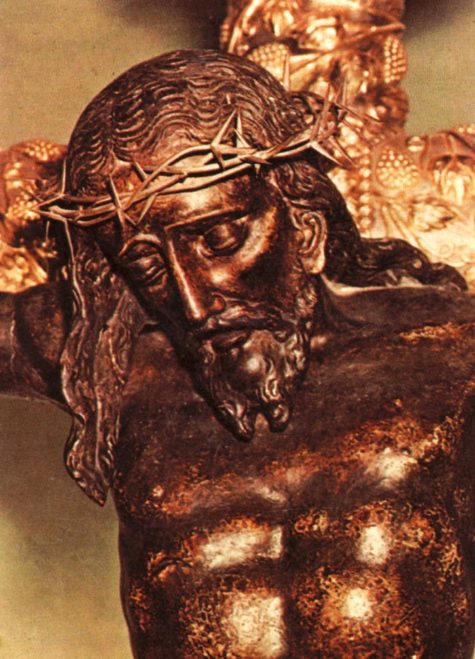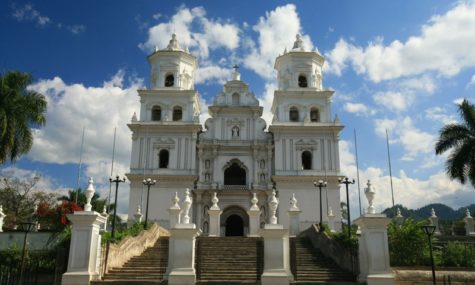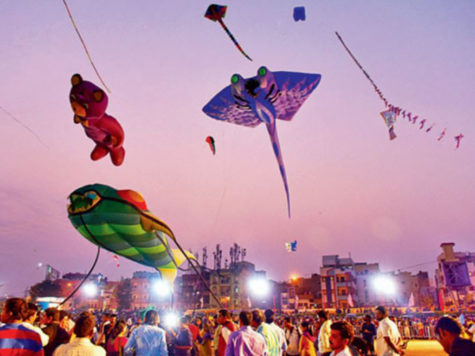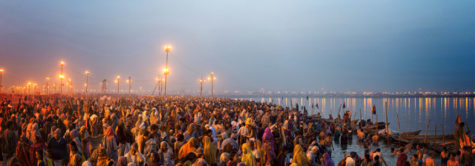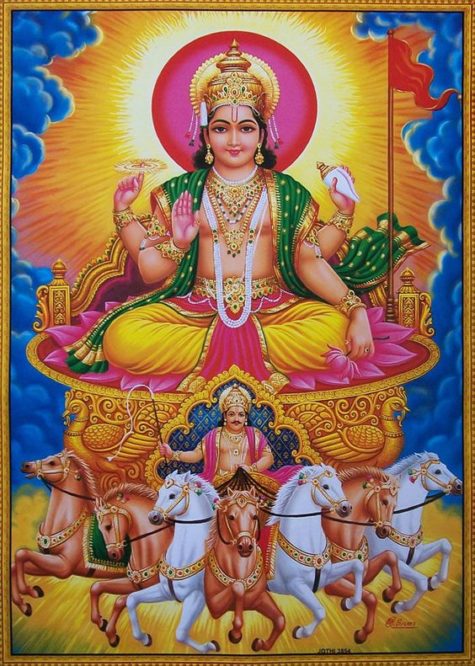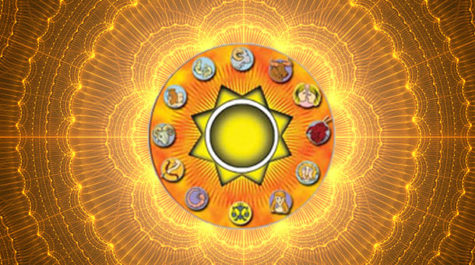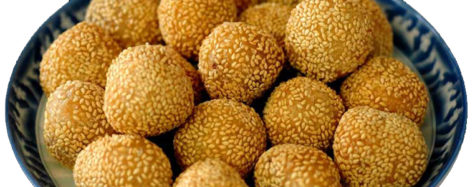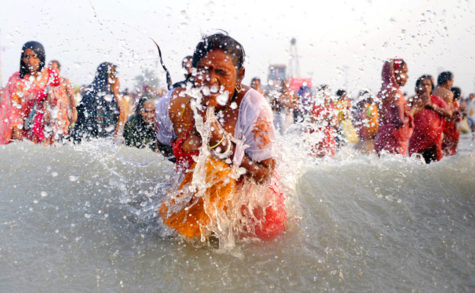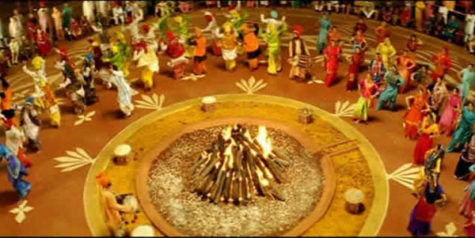Pisces is the twelfth sign of the zodiac. The sun enters Pisces at slightly different times each year, usually around Feb 21, sometimes the day before or the day after.
- Symbol: Two Fish swimming in opposite directions
- Element: Water
- Gemstone: Aquamarine
- Keyword: I Believe
From 365 Goddess, we have this for today:
- Themes: Foresight; Divination; Inspiration; Femininity; Psychic Abilities; Kindness; Tradition
- Symbols: A Cup; Fishes; Water
- Presiding Goddess: Saga
About Saga:
Saga, an attendant of Frigg, is a Scandinavian goddess whose name beans “seeress.” Saga is a student of the Universe, ever watchful and ever instructing us about the value of keen observation. She is directly connected with the sign of Pisces, which governs artistic expression, psychic abilities, and sensitivity towards others’ needs.
In artistic representations, Saga bears a long Viking braid, an emblem of womanhood and honor. According to the Eddas, Saga lives at Sinking Beach, a waterfall, where she offers her guests a refreshing drink of inspiration from a golden cup. Later, her name was applied to the sacred heroic texts of the Scandinavian people.
To Do Today:
Tend your sacred journals today. Write about your path, your feelings, where you see yourself going, and where you’ve been. Saga lives in those words – in your musings, memories, and thoughts – guiding them to the paper to inspire you now and in the future.
Invoke any of Saga’s attributes in your life today simply by practicing the art of observation. Really look at the world, your home, and the people around you. As you do, remember that little things count. Saga’s insight lies in the grain of sand and the wildflower as well as the stars.
More About the Sun in Pisces
The Sun is in Pisces from February 19 to March 20, depending on the year.
- Ruler: Neptune
- Season: Winter
- Modality: Mutable
- Metal: Tin
- Stone: Jade. Coral
- Color: Sea Green
- Flowers: Jonquil; Violet; Poppy
- Anatomy: Feet, Veins
- Attributes: intuitive, dreamy, artistic, humane, sympathetic, sensitive, compassionate, perceptive, tender, impressionable
As the twelfth and last sign of the zodiac, Pisces contains within itself a little experience of all the signs. This gives Pisces Suns the ability to identify with people from all walks of life—from all backgrounds—in some way. These individuals are not only changeable and adaptable, they have open minds and tremendous understanding. But Pisces itself is often misunderstood. Pisces Suns may spend a good portion of their lives yearning for understanding, and the other part in a state of divine discontent. Suffering is sometimes glamorized in the Piscean world.
Sun in Pisces people are frequently pegged as wishy-washy, but this is all a matter of opinion. What you will find behind a vaguely directionless, spacey manner is a deep person with real dreams. Their dreams are more than getting that picket fence or making it up the corporate ladder. Pisces are tuned in to a higher purpose and their dreams transcend the individual. A deep love for humanity, and compassion that knows no bounds is found with this placement of the Sun.
Pisceans are not known to be cutthroat business types, nor are they given to throwing themselves out into the world in an aggressive manner. But make no mistake about it, Pisces can be extraordinarily successful when given the chance to express themselves. The arts, marketing, music, teaching, drama, healing arts…these are all fields in which Pisces can find expression. Their imagination, attunement to humanity, and remarkable intuition endow them with enviable gifts of insight and creativity.
Pisces is a sensitive sign—both sensitive to criticism and sensitive to others’ feelings. Easily touched by human suffering, at least in theory, Pisces wouldn’t hurt a fly. They believe in people, are deeply hurt by compassionless human behavior, and have a hard time saying no. Harsh realities are avoided either through escapist behavior or self-delusion; but every now and again reality does raise its ugly head, and hits Pisces over the head. This is a sad time indeed. Pisces retreats into their own world, self-pitying and giving pep talks to themselves (“I will never trust again!”). Rest assured, though, that these periods are rather short-lived and even useful.
Pisces seems to derive energy from their (generally short) bouts of self-pity. They come back stronger, with a spring in their step, ready to face the world again, and just as, if not more, compassionate and trusting as they were before. Some might even wonder if Pisces finds pleasure in suffering. Sometimes this is the case, but most of the time, Pisces pulls a lot of creative energy from sadness. Pisces is the poet or artist with angst, although this trait is often more apparent with Moon in Pisces.
Some find Pisces’ tendency to be late for appointments, spaced out behavior, and absent-mindedness amount to irresponsibility. Pisces would be shocked to know this, however. Who me? Pisces wonders. Irresponsible? Pisces Suns absolutely care—their love knows no bounds—but their retreats from ordinary life (whether they are as simple as daydreams or actual departures) that they so seem to need every now and again are not always understandable to no-nonsense signs, such as Virgo or Aries.
Many Pisces seem almost allergic to things like shopping lists, maps, directions, and instructions, and for some brave souls, even watches — they prefer to feel their way through life than to follow some plan.
We find plenty of artists, poets, and musicians with Sun (and other personal planets) in Pisces. Piscean themes are woven throughout the songs of Billy Corgan of the Smashing Pumpkins and Kurt Cobain of Nirvana, for example.
Source: Cafe Astrology
Anthesteria, held on February 11th, celebrates the maturing of the wine and the beginning of spring. It’s an Athenian festival in honor of Dionysus, god of the grape harvest, winemaking, and wine. The celebration lasted for three days in the month of Anthesterion (from the Hellenic calendar in ancient Attica).
The word Anthesteria is associated with “flower” or the “bloom” of the grape. A. W. Verrall (Journal of Hellenic Studies, xx., 1900, p. 115) wrote that it was a feast of “revocation” where the dead were recalled to the land of the living.
In ancient Greece, Anthesteria was the name of a festival during which the participants ritually expelled the Keres, evil female spirits, from their houses.
- The First Day
On the first day, called Pithoigia (opening of the casks), wine from the newly opened casks was offered to Dionysus and everyone in the household, including servants and slaves. The home and children were adorned with spring flowers.
- The Second Day
The second day, named Choës (feast of beakers), was for visiting. People dressed for the day, some even dressed as Dionysus. They spent the day visiting friends and family as well as the local drinking clubs were drinking games were held. Some folks offered wine to deceased relatives by pouring libations on the their tombs.
For the state, however, if was a formal day with secret ceremonies in one of the sanctuaries of Dionysus. The basilissa (or basilinna), wife of the archon basileus, would marry the god of wine in a special ceremony. She was assisted by fourteen Athenian matrons, called geraerae, who the basileus chose and swore to secrecy.
Both Pithoigia and Choës were considered unlucky and defiled days that necessitated atoning with libations. From this the souls of the dead would come up from the underworld and walked the earth. People chewed on buckthorn leaves and smeared tar on their doors to protect themselves from evil.
- The Third Day
The third day, Chytri (feast of pots), was a festival of the dead. Cooked legumes were offered to Hermes, son of Zeus, and he would make the souls of the deceased depart.
Sources:
The “L’Hom Strom” festival takes place on the first Saturday in February every year the small community of Scuol in canton Graubünden, (in Switzerland close to the borders of both Austria and Italy). The “hom strom” is the famous “Straw Man of Scuol,” a large dummy.that is set alight.
On the first Saturday in February, young men crack whips to assemble the population, and the youths of Scuol, then go from farm to farm collecting straw which has been hand-threshed and especially prepared for this purpose. The straw is taken down to the village square where the thick strands of rye are then twined around a telephone pole which is almost eight meters (24 ft) long. The work must be done by noon, at which time the bundle should have reached a diameter of approximately two meters.
In the afternoon, a group of adults take the “l’hom strom” to Gurlaina and place the Hom Strom in a specially prepared hole in a field, and there set up ready for burning. The enormous effigy is carefully guarded to protect him so that pranksters – specifically the boys from the next village – cannot light him before his time!
At dusk, the people of Scuol parade through the village streets singing songs on the way to Gurlaina. As night falls, the dummy is burned, accompanied by songs to drive away the winter.When the tower clock strikes eight, the oldest boys throw balls of fire, which are rags drenched in petroleum and which have up to now illuminated the grounds, at the Hom Strom and set him aflame.
At the end of the burning ceremony attending locals sing the fourth stanza of the song Hom Strom written in the 50’s by Men Rauch, born and raised in Scuol, where a Christian adaptation is easily recognizable:
Las flommas van in ot,
portond al Segner lod,
chi’ns dosta dal malom,
eviva nos Hom Strom!!
Translation:
The flames that burn up into the sky,
give praise to the Lord,
who, in turn, protects us from evil,
long live our straw man!!…
The children and adults sing the Hom Strom song, written by a native poet. Half an hour later, the spirit of winter is consumed and everyone walks back to the village. This death by fire symbolizes the rapidly approaching end of winter.
~Info from various sources
Februalia, Februa, and also Februatio, was the Roman festival of ritual purification, later incorporated into Lupercalia. The festival, which is basically one of Spring washing or cleaning (associated also with the raininess of this time of year) is old, and possibly of Sabine origin. According to Ovid, Februare as a Latin word which refers to means of purification (particularly with washing or water) derives from an earlier Etruscan word referring to purging.
The Roman month Februarius (“of Februa,” whence the English February) is named for the Februa/Februatio festival, which occurred on the 15th day of the Roman month. A later Roman god Februus personified both the month and also purification, and is named for them. Thus, the month is named for the festival and not for the god.
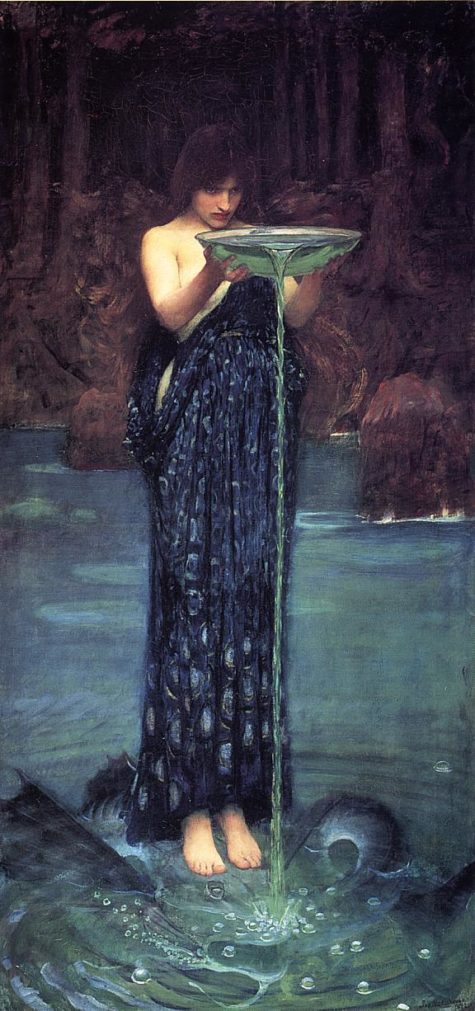
Here is a ritual for Februata, and is appropriate any day during the month of February:
- Color: White
- Element: Earth
- Altar: Spread with a clean white cloth and place thereupon four white candles and a bowl of water, very simply.
- Offerings: Clean something externally, and at the same time clean something internally.
- Daily Meal: Fasting for the day. Drink plenty of water.
Februata Invocation
The winter has lain heavily upon us,
Juno Februata, Queen of the new light,
And we are sunk in layers of thought
Like a hibernating mole
Beneath layers of earth.
Bring us forth into the light, Lady!
Let us remove all filth
From our bodies and our souls,
Making them a place of clarity.
Chant:
Februus Februus Lucina Lucina
(There is no further ritual; all silently take cleaning tools and being to thoroughly clean the entire building, ending with a ritual bath. As each cleans, they should meditate on what part of the mind or spirit needs cleansing, and let the physical cleansing aid in the spiritual aspect.)
Sources: Wikipedia and Pagan Book of Hours
Aquarius is the eleventh sign of the zodiac. The sun enters Aquarius at slightly different times each year, usually around Jan 21, sometimes the day before or the day after.
- Symbol: The Water Carrier
- Element: Air
- Gemstone: Amethyst
- Keyword: I Know
Aquarians are believed to be sympathetic, peace-loving, and strong-willed. They are independent, tolerant, broad-minded, intellectual humanitarians. Aquarians are progressive thiners, and are constantly looking ahead. They sometimes give the impression of being detached or aloof, as they can remove their emotions from everyday events.
From 365 Goddess, we have this for today:
- Themes: Justice; Tradition; Zeal; Femininity
- Symbols: Fire; Water
- Number: Nine
- Presiding Goddess: Oya
About Oya:
A Yoruban mother goddess and spirit of the river Niger. Oya flows with us through the last day of January, strengthening our passion for and appreciation of life. She is wild and irrepressible, like the fire she’s said to have created, yet Oya presides over matters of fairness and custom, using that fire as the light of truth. Artistic depictions of Oya show a nine-headed woman whose bosom speaks of fertile femininity.
To Do Today:
Enjoy a glass of water when you get up to begin generating Oya’s zest for life in your body and soul. This is also very suited to the energies of the day. Aquarius represents the Water Bearer who continually pours inspiring, creative waters from celestial spheres into our lives.
Get out and do something today. Invoke Oya through your pleasure and pure excitement. Dare to dream; then try to make that dream come true somehow.
If there’s some area in your life that needs more equity, try making this Oya charm:
Take any small candle and carve Oya’s name into it. Have a glass of water nearby. Light the candle to invoke the goddess. Hold the water over the candle, saying:
What injustice consumes,
Oya’s waters quell.
Drop a little water on the candle, then trim off the taper, carrying it with you to draw justice to you.
More About the Sun in Aquarius:
The Sun is in Aquarius from approximately January 20 to February 18, depending on the year.
- Ruler: Uranus
- Modality: Fixed
- Season: Winter
- Metal: Uranium
- Stone: Amethyst
- Color: Sky Blue
- Flowers: Violet; Carnation; Lily
- Anatomy: Ankles, shins, circulation
- Attributes: individualistic, assertive, independent, humanitarian, inventive, original, eccentric, opinionated, intellectual, idealistic, cool, friendly, detached
One of the standout characteristics of those born under the Sun Sign of Aquarius is their unwillingness to follow the beaten track. With advancement and progress on their minds, there can be an irreverence to old and outdated ways of thinking and doing things.
Many Aquarians aim to free themselves of personal and social conditioning. Although open to change in theory, Aquarians can be surprisingly stubborn. Their idealism runs strong, but they can be very fixed in their opinions.
Often a bit aloof and even standoffish, Aquarians nonetheless are usually well-liked. They are curious and observant, and tolerant in a broad sense. Prejudice and bias is offensive to the typical Aquarius.
Aquarians are generally very clever, witty, and intellectual. They value progress and frankness. It’s difficult to throw Aquarians for a loop—they’re generally on top of things.
There is a bit of reformer in Aquarius. They’ll try to get you to see through superficiality, and encourage you to be open and forthright. “Be true to yourself” and “Don’t follow the crowd” are mottos we easily associate with this sign.
Aquarians need space and value personal freedom. Any attempt to box them in will likely fail. They’ll happily return the favor; and they will treat people from all walks of life as equals. Equality and fairness are hallmarks of the sign. If you’re quirky and “different”, all the better.
Source: Cafe Astrology
Pongal is the first harvest festival of the year and the celebrations go on for four days. This is a sacred festival for Tamilians all over the world and the best celebrations take place in the state of Tamil Nadu. It falls on January 14 this year and the date pretty much remains constant over the years, sometimes it falls on January 15 as well. Pongal is also called Thai Pongal as the festival marks the beginning of the Tamil month Thai. This is considered to be an auspicious one and people celebrate it with much enthusiasm.
Thai month is believed to bring good luck by vanishing one’s problems away and therefore people look forward to celebrating Pongal. The harvest festival is celebrated over four days with each day having a different ritual. Here is how Pongal is celebrated in Tamil Nadu.
Pongal is a harvest festival and since rice is one of the main crops grown here, it is given due importance during the rituals. Even turmeric and sugarcane are grown in Tamil Nadu. The harvest festival is in the month of Thai which is considered auspicious for weddings as well.
Pongal is all about letting go of the past and welcoming new things in life. Pongal is also known as Thai or Tai Pongal. People celebrate it to thank Lord Sun for a good harvest season. The four-day festivities are:
- Bhogi Pongal:
The first day of the four-day festivity is Bhogi Pongal. It marks the last day of Marghazi, Tamil month. People celebrate it together by lighting bonfires and burning discarded items.
The first day of Pongal is celebrated by paying respect to the rain gods who are responsible in ensuring a good crop year. People offer their prayers by thanking Indra for this blessings and ask for a good year again. People also light up a bonfire and throw the items they want to discard in it. In the evening, women sing and dance around the bonfire which helps keep warm as well as the night gets chilly.
- Surya Pongal:
The second day is Surya Pongal. It is dedicated to Lord Sun or Surya Dev. People thank him for providing a good harvest and seeking blessing for happiness and prosperity. On this day, the houses are decorated with banana and mango leaves.
The second day of the harvest festival has more elaborate rituals where the women of the house decorate the area outside the house using white powder in the morning. Then, rice is boiled in milk in an earthen pot outside the house. Sugarcane sticks are used for decoration along with banana leaves and turmeric plant. This rice is offered to the sun god who again is responsible for a good harvest.
The word Pongal translates to boil over and boiling rice signifies its name. On this day, people also wear new, ethnic wear for the celebrations.
- Mattu Pongal:
The third day marks Mattu Pongal. Mattu means cow, cattle or bullock. This celebrates cattle as they provide dairy products, fertilizers and agriculture support. This day of Pongal is reserved for offering prayers to cows who are considered a sacred animal for Hindus.
The cows horns are painted and adorned with bells and flowers around their neck. Women then perform aarti to get rid of any evil eye and seek the animal’s blessings. Cows are then paraded in the village and the tiny bells reverberate their arrival. There is a cheer in the atmosphere and villagers also organize cattle races on this day.
- Kanum Pongal:
The last day is Kanum Pongal. This day strengthens the bond between people. A lot of people come together and celebrate it.
The last day of Thai Pongal celebrations end with a pooja right outside the home. Women wake up in the morning and before bathing, they place a washed turmeric leaf on the ground. Different kinds of rice are placed on it along with sugarcane sticks, betel nuts and more. The pooja performed is essentially for their brothers, to ensure they prosper in life. This marks the end of the harvest festival celebration in Tamil Nadu.
Pongal Stories
There are two major stories that revolve around the celebration of Pongal.
Once, Lord Shiva had asked Basava, his bull, to travel around the world to inform people to eat once a month, have a bath and oil massage every day. Basava communicated exactly the opposite of what he was told. He told people to bathe once a month and eat everyday. This angered Lord Shiva and he ordered Basava to go into exile. He was made to assist people while ploughing. This is why cattle are linked with the harvest.
There is another story to it. According to a few people, Lord Krishna told the people of Gokul to stop worshipping Lord Indra as he was arrogant and was filled with pride. This angered Lord Indra. He caused thunderstorms and flooding. To protect people, Lord Krishna lifted Mount Govardhan on his little finger to provide shelter to people. Lord Indra realized his mistakes and asked for forgiveness from Lord Krishna.
Pongal Quotes and Invocations:
These are actually meant for greeting cards, but I thought they would make something nice to say over a meal, or during a meditation during these four days.
- As you offer thanks to the hero of your farmland – the Cattle, May the festival of Pongal which heralds the beginning of harvest season Bring you happiness, joy, prosperity and wealth. Pongalo Pongal!
We thank sun for burning himself to save us.
We thank plants sacrificing their life for us.
And we thank all the creatures helping us to live in this world for some time.
- The sun shines bright
To guide and lead us the way
Towards bountiful harvest season
May we be blessed with prosperity and joy
May the sweetness of overflowing milk and sugarcane
Fill our home with harmony and happiness
- May the love and affection
Overflow from your heart
like Pongal milk from the pot
Pongalo Pongal
As you shout Pongalo Pongal
To welcome the prosperity and wealth
along with the overflowing Milk
I wish you everlasting happiness and joy
Ven Pongal Recipe
Pongal is a delicious South Indian porridge made with rice and yellow moong lentils. It can be made sweet or savory. Here I share the savory version of pongal recipe known as Ven Pongal or Khara Pongal laced with the wonderful flavors of cumin, asafetida, curry leaves, ginger and black pepper. Not to forget the lovely aroma of ghee, in it.
Main Ingredients:
- ½ cup rice – any medium to short grained or regular rice, 100 grams
- ¼ cup moong dal or 60 grams moong dal
- ½ teaspoon cumin seeds – lightly crushed
- ⅛ teaspoon asafoetida (hing)
- 1 inch ginger – chopped or 1 teaspoon heaped chopped ginger
- 3 to 3.25 cups water or add as required
- salt as required
For Tempering:
- 1 teaspoon cumin seeds
- 1 teaspoon black peppercorns whole or crushed, you can also add ½ teaspoon black pepper
- 1 sprig curry leaves or 10 to 12 small to medium curry leaves
- 10 to 12 cashews – whole or halved
- 2 to 3 tablespoons Ghee (clarified butter)
Instructions:
Pick moong lentils first to get rid of stones if any. Then heat a small pan or a small kadai and add the moong lentils. On a low flame stirring often roast the moong lentils till they become aromatic. The moong lentils only need to be roasted till they become aromatic. No need to brown them.
Now take them in another bowl or you can use the same pan for rinsing. Add rice in the bowl containing the roasted moong dal. Rinse both rice and roasted moong dal a couple of times with water. Drain very well and then add them in a pressure cooker.
Now add the following ingredients:
- Cumin seeds
- Asafetida (hing)
- Chopped ginger
- Salt as per taste.
Pour in 3 to 3.25 cups water. The amount of water to be added depends on the consistency you want and also on the quality of moong dal. Pressure cook on a medium to high flame for 7 to 8 whistles or 11 to 12 minutes.
Let the pressure settle down on its own and then you remove the lid to check the doneness and consistency. If the pongal has a consistency like that of pulao, then add ½ to 1 cup hot water and mix very well.
Both the rice and the moong dal should be cooked very well. If you want you can even slightly mash the cooked rice and moong lentils. If cooked well, then cover with the lid and keep aside.
Tempering:
In another small pan, heat the ghee. Add the cumin seeds. Let them splutter. Then add the cashews. Fry until the cashews become light golden. Once they begin to get light golden, then add black peppercorns and 10 to 12 curry leaves.
Stir very well and fry until the curry leaves become crisp. The black pepper should also be fried well.
Putting It All Together:
Now pour this entire tempering on the pongal. Mix very well. Cover with the lid (with the vent weight/whistle on the lid) and keep ven pongal aside for 5 to 6 minutes. This allows the tempering flavors to infuse with the pongal and the aroma to stay in. Then remove the lid and serve hot with coconut chutney or sambar.
Sources:
Shinto holy day marking a new year. On this day the faithful visit shrines to thank the kami (spirits within objects in the Shinto faith), ask the kami for good fortune, and make resolutions for the year ahead.
Traditionally, Shinto practitioners observe this New Year holiday by visiting the shrines, mostly at midnight and praying for the renewal of their heart, prosperity and health in the year to come. It is also common to visit close friends and family to express good wishes.
This festival concentrates on the deep unrecognized awareness and respect for the divine energy that permeates all forms of life. It is one of the most significant yearly festivals in Shintoism.
Though the New Year is predominantly celebrated on the first day of the year, traditionally the Shinto’s celebrate Gantan-sai for a prolonged span of seven days.
Much like Christmas for Christians, Gantan Sai has become a national holiday in Japan and expanded out past the Shinto religious practices and evolved into a national holiday. It is referred to as the Japanese New Year or Shogatu .It is observed on the first day of the Gregorian calendar i.e. the 1st of January and is the annual New Year celebration of the Shinto religion.
Originally, the date of the Japanese New Year was decided according to the Chinese Lunar Calendar and the date varied each year. However, in 1873, five years since the Meiji Restoration, the people of Japan adopted the Gregorian calendar and fixed the date of Japanese New Year or Shogatu to be the 1st of January every year, and it has been so ever since.
Traditions and Practices:
During this festival, most Shinto’s spend the holiday by visiting sacred Shinto temples at the hour of midnight.
During this visit, they wear their finest clothes and pray that their hearts be renewed and purified of all dirt and uncleanliness.
- Blessings for health, happiness and prosperity are also requested for the upcoming year.
- This festival also witnesses friends and families coming together to wish well for each other.
On this day, people eat traditional food with their families. Gantan-sai day meals involve a special compilation of dishes known as “Osechi”. The typical New Year Day menu comprises of dishes like Ozoni a soup, Mochi with vegetables, Kamabokoa puree of steamed white fish, Kurikinton mashed sweet potato with chestnut and Kuromame sweet black beans.
Source: Gatan-sai
The Black Christ of Esquipulas is a wooden image of Christ now housed in the Cathedral Basilica of Esquipulas in Esquipulas, Guatemala. A lovely Baroque structure painted a gleaming white, the basilica dominates the town’s skyline. Remarkably, it has survived many earthquakes over the centuries with little damage.
The image is known as “black” because over more than 400 years of veneration its wood has acquired a darker hue, although such a name is relatively recent – in the 17th century it was also known as the “Miraculous Lord of Esquipulas” or the “Miraculous Crucifix venerated in the town called Esquipulas”.
The Black Christ is housed in a glass case on the altar at the east end of the basilica. A large statue that depicts Christ suffering on the cross, it is part of a Crucifixion group with Mary Magdalene and St. John.
Pilgrims stand in line along the west side of the church to see El Cristo Negro up close, sometimes waiting for over an hour. After viewing the statue and saying their prayers, pilgrims back away from it on the other side, believing it an offense to turn their back on the holy image.
Tens of thousands of devout Catholics cram into Esquipulas during the annual celebration of the Black Christ which happens on January 15th. They come to pray and ask for help in front of a religious icon which has been credited with miraculously curing Pedro Pardo de Figueroa, the Archbishop of Guatemala, from a serious illness in 1737.
The largest number of pilgrims come from Guatemala, El Salvador, Honduras, Mexico, Nicaragua and other Central American countries. The January 15th festival is also marked in the United States of America in cities such as Los Angeles, New Jersey and New York with a high Central American population.
Special processions and services are also held on July 21-27, and during Holy Week each year.
History of Esquipulas Basilica
The statue of the Black Christ (El Cristo Negro) was comissioned by Spanish conquistadors for a church in Esquipulas. It was carved in 1594 by Quirio Cataño in Antigua and installed in the church in 1595. By 1603, a miracle had already been attributed to the icon, and it attracted increasing numbers of pilgrims over the years.
The history of the Basilica begins in 1735, when a priest named Father Pedro Pardo de Figueroa experienced a miraculous cure after praying before the statue. When he became Archbishop of Guatemala, he commissioned a beautiful basilica to properly shelter the beloved statue. The church was completed in 1759.
Perhaps an even more impressive miracle is the fact that Esquipulas was the site of a Central American peace summit which laid the groundwork for what became the Guatemalan Peace Accords of 1996 which ended the country’s ghastly 36 year civil war.
The Basilica de Esquipulas is such a major religious site that Pope John Paul II paid a visit in 1996 to mark the 400th anniversary of the church which the Pope is said to have called “the spiritual center of Central America.” In 2009, celebrations were held to mark 250 years since the basilica’s construction.
Sources: Wikipedia, Sacred Destinations and Trans Americas
Thorrablot (Þorrablót) was a sacrificial midwinter festival offered to the gods in pagan Iceland of the past. It was abolished during the Christianization of Iceland, but resurrected in the 19th century as a midwinter celebration that continues to be celebrated to this day. The timing for the festival coincides with the month of Thorri, according to the old Icelandic calendar, which begins on the first Friday after January 19th (the 13th week of winter). Or, on the 19th when it falls on a Friday.
Origins of the name “Thorri” are unclear but it is most likely derived from Norwegian king Thorri Snærsson, or Thor the God of Thunder in the old Nordic religion.
Today Thorrablot are common events among Icelanders everywhere and can be anything from an informal dinner with friends and family to large organised events with stage performances and an after-dinner dance. These large Thorrablot celebrations are usually arranged by membership associations, associations of Icelanders living abroad, and as regional festivals in the countryside.
On this occasion, locals come together to eat, drink and be merry. Customary, the menu consists of unusual culinary delicacies, known as traditional Icelandic food, which consist of different versions of animal parts, either fermented in lactic acid, rotten, salted or soured. These include rotten shark’s meat (hákarl), boiled sheep’s head, (svið) and congealed sheep’s blood wrapped in a ram’s stomach (blóðmör)! This is traditionally washed down with some Brennivin – also known as Black Death – a potent schnapps made from potato and caraway.
Even though most Icelanders do indulge in the traditional foods at least once a year, not many foreigners, nor the younger generation of Icelanders like the food.
After the Thorrablot dinner traditional songs, games and story telling are accompanied by dancing and in true Icelandic style continue until the early hours of the morning! If you fail to receive a personal invitation to a family feast, local restaurants will often add Thorrablot color and taste to their menus.
Makar Sankranti (also known as Makara Sankranthi or Maghi) refers both to a specific solar day in the Hindu calendar and a Hindu festival in reference to deity Surya (sun) that is observed in January every year. It marks the first day of sun’s transit into the Makara (Capricorn), marking the end of the month with the winter solstice and the start of longer days.
- Significance: Festival of Harvest, welcome longer days, sun worship
- Celebrations: Kite flying, bonfires, fairs, surya puja in river, feast, arts, dance, socialization
Makar Sankranti is one of the few ancient Hindu festivals that has been observed according to solar cycles, while most festivals are set by the lunar cycle.
Being a festival that celebrates the solar cycle, it almost always falls on the same Gregorian date every year (January 14), except in rare years when the date shifts by a day for that year, because of the complexity of earth-sun relative movement.
Makar Sankranti is observed with social festivities such as colorful decorations, rural children going house to house, singing and asking for treats (or pocket money), fairs, dances, kite flying, bonfires and feasts.
The Magha Mela is mentioned in the Hindu epic, the Mahabharata, thus placing this festival to be around 2,000 years old.
Makar Sankranti is regarded as important for spiritual practices and many people take a holy dip in sacred rivers or lakes, especially Ganga, Yamuna, Godavari, Krishna and Cauvery. The bathing is believed to result in merit or absolution of past sins.
Every twelve years, the Hindus observe Makar Sankranti with one of the world’s largest mass pilgrimage, with an estimated 40 to 100 million people attending the event. At this event, they say a prayer to the sun and bathe at the Prayaga confluence of the River Ganga and River Yamuna at the Kumbh Mela.
Because the festival is dedicated to the Hindu sun god, Surya, people also pray to the sun and thank for their successes and prosperity. The traditional prayer to the sun is the Gayatri Mantra.
The Gayatri Mantra
The mantra is a hymn to the sun which represents both the physical sun and the Divine in all things. Here it is:
Om bhur bhuvah svah
tat savitur varenyam
bhargo devasya dhimahi
dhiyo yo nah prachodayat.
The eternal, earth, air, heaven
That glory, that resplendence of the sun
May we contemplate the brilliance of that light
May the sun inspire our minds.
Chanting the mantra serves three purposes.
- The first is to give back to the sun. The sun gives but never receives. The mantra is a gift back to the sun, an offering of gratitude to refuel the sun’s gracious offering.
- The second purpose is to seek wisdom and enlightenment. The mantra is a request to the sun: May we meditate upon your form and be illumined by who you are? (Consider that the sun offers its gift of illumination and energy to all beings, without judgment and without attachment to the outcome of the gift.)
- Finally, the mantra is an expression of gratitude, to both the life-giving sun and the Divine. The sensibility it evokes is more important than the literal meaning. It’s an offering, a way to open to grace, to inspire oneself to connect to the ancient vision of India.
An Auspicious Period
Makar Sankranti is regarded as the beginning of an auspicious phase or the holy phase of transition. It also marks the end of an inauspicious phase which begins around mid-December. Further it is also believed that any sacred ritual can be performed from this day onwards. The auspicious day of Makar Sankranti marks the beginning of warmer and longer days as compared to nights.
Makar Sankranti is all about forgetting bitter and sad moments which happened in the past and welcoming the new phase of life which is full of purity, knowledge and wisdom.
The Significance of Makar Sankranti
The significance of the Makar Sankranti festival is that it marks the day where there is a significant movement in the zodiac ~ the arrangement of the earth’s dial around the sun ~ and this movement brings about a new change in the way we experience the planet itself.
There are many sankrantis through the year; the two significant ones being Makar Sankranti, and right opposite, after summer solstice is Karka Sankranti. In between, there are many Sankrantis ~ every time the zodiac sign changes, it is called a Sankranti to suggest the movement of the planet, to understand that our life is sustained and nourished by this movement. If this movement ceases, everything about us will cease.
On the 22nd of December, the solstice happened, that means in relation to the sun, the movement or the tilt of the planet reaches its maximum. Now, from this day on, the northern movement is strong. Things really start changing upon the earth. From Makar Sankranti onwards, winter is being relieved step by step.
This movement is also a significant aspect in the way we reap from this planet. There was a time when human beings could eat only what the earth offered. Then we learned how to get what we wanted from the earth; this is called agriculture. When we were hunting and gathering, we only picked up what was there.
It is like when you were an infant, you ate or swallowed whatever your mother gave you. When you became a child, you asked for what you wanted. So we grew up a bit and started demanding and getting what we wanted, but still, you can only get what you want to a point that She is willing. If you stretch it beyond that, you will not only not get it, you will get something else. That is called industrialization.
Agriculture is coaxing the Mother to give what you want. Industrialization is ripping her apart. I am not speaking against something. I want you to understand the way our minds are transiting, the way human activity is transiting from one level to another.
So this is a day when we remind ourselves that everything that we are is what we take from this planet. I see everywhere in the world, people are talking about giving. I don’t know from where they give. You can only take ~ either you take gently or you grab. Did you come with your own property from somewhere? What is there to give? You can only take. Everything is offered. Take sensibly, that is all there is.
Some Thoughts About Movement
Makar Sankranti is celebrated as a very important festival in India. Sankranti literally means “movement.” Everything that we recognize as life is movement. Fortunately, people who came before us have moved on, and people who come after us are waiting for us to move on ~ don’t have any doubts about this.
The planet is moving and that is why it churns up life. If it were still, it wouldn’t be capable of life. So there is something called movement in which every creature is involved, but if there has to be movement, this movement has to be housed ~ this movement can only happen in the lap of stillness. One who does not touch the stillness of his life, one who does not touch the stillness of his being, one who does not know or has not tasted the stillness within and without, will invariably get lost in the movement.
Movement is pleasant only to a point. The planet earth is moving gently in such a beautiful manner ~ it is only changing seasons. Tomorrow, if it just speeds up, throttles up a little bit, then all our seemingly balanced minds will become imbalanced, everything will spin out of control. So movement is beautiful only to a certain point. Once it crosses that point, movement becomes torture.
So Makar Sankranti is a festival to recognize the movement, movement being celebration, movement being life, movement being the process of life and the beginning and the end of life. At the same time, the word ‘shankara’ is used to remind you that the one behind this, Shiva, is a still one; stillness is the basis of movement.
Though all the other planets are moving, the most important one is not moving. If the sun also takes a walk, then we are in trouble. He hangs there not moving. That is why everybody else’s movement is okay. But his stillness is relative because the whole solar system may be moving; the whole galaxy may be moving. So beyond that, the space which holds all this is absolute stillness.
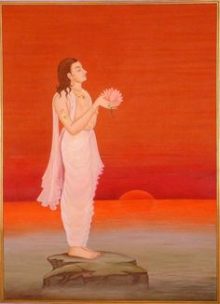 When a human being makes the necessary effort to touch the stillness within himself, only then he knows the joy of movement. Otherwise, people are bewildered by the movement of life. Every change that happens in their life they suffer.
When a human being makes the necessary effort to touch the stillness within himself, only then he knows the joy of movement. Otherwise, people are bewildered by the movement of life. Every change that happens in their life they suffer.
These days, the so-called modern life is like this ~ any change means you must suffer. Childhood is tension, puberty is great suffering, middle age is unbearable, old age is abhorred and feared, and death is celebration ~no that is pure terror.
Every stage of life is a problem because people have a problem with movement, not understanding that the very nature of life is movement. You can only enjoy and celebrate movement if you have one leg stuck in stillness. If you know what stillness is then movement would be a pleasure. If you do not know what stillness is, if you have no contact with stillness, movement is bewildering.
People are trying to track the movement. Looking at the stars, looking at lines in their hands and looking at all kinds of signs including the tea leaves. People want to read the movement of their lives somehow. This struggle with movement, this paranoia about movement, is happening because there is no taste of stillness.
If there was a taste of stillness in you, movement would not disturb you. It is something which sets a certain rhythm. Every rhythm has a beginning and an end; every movement has a beginning and an end. Movement means that which is in transition. Stillness means that which always is. Movement means compulsiveness, stillness means consciousness.
The significance of Makar Sankranti is that it is the time to remind yourself that celebrating movement is possible only when there is a taste of stillness within you.
Regional Celebrations
Because the festival is celebrated in winter, people start preparing food which can give them give them energy and also keep their body warm. Tilguls ~ Laddu of Til (Sesame) is made up of Jaggery and devotees also pay respect to Goddess Saraswati.
This type of sweet is a symbolism for being together in peace and joyfulness, despite the uniqueness and differences between individuals.
People greet each other Happy Sankranti by saying Tilgul Ghya Aani God God Bola.
For most parts of India, this period is a part of early stages of the Rabi crop and agricultural cycle, where crops have been sown and the hard work in the fields is mostly over. The time thus signifies a period of socializing and families enjoying each other’s company, taking care of the cattle, and celebrating around bonfires.
The Makar Sankranti festival is also known and referred to as the harvest festival because this is the time when harvesting is complete and there are big celebrations. This is the day we acknowledge all those who assisted in making the harvest. The farm animals play a huge role in harvesting, so the following day is for them and is called Mattu Pongal.
The first day is for the earth, the second is for us and the third is for the animals and livestock. See, they are placed a little higher than us because we exist because of them, they do not exist because of us. If we were not here, they would all be free and happy. But if they were not here, we couldn’t live.
These festivals are a reminder that we need to craft our present and our future in a conscious manner.
Also, on this day there are several Melas or fairs which are been held and one of the most famous among all melas is Kumbh Mela. It is been held every 12 years at one of four holy locations namely Haridwar, Prayag, Ujjain and Nashik.
The Magh Mela which is the mini mela is held annually at Prayag, the Gangasagar Mela held at the Ganges River, Tusu Mela in parts of Jharkhand and West Bengal and many more such fairs are been held on this auspicious day.
Regional Names
Known by different names and celebrated with different customs in different parts of the region, Makara or Makar Sankranti is an important pan-Indian solar festival observed on the same date, sometimes for multiple dates.
It is known as Pongal in Tamil Nadu, Pedda Panduga in Andhra Pradesh, Biku in Assam, Magha Mela in parts of central and north India, as Makar Sankranti in the west, and by other names. The festivities associated with Makar Sankranti are known by various names such as Lohri by north Indian Hindus and Sikhs, Sukarat in central India, Bhogali Bihu by Assamese Hindus, and Pongal by Tamil and other south Indian Hindus.
Wikipedia gives us this list:
- Suggi Habba, Makar Sankramana , Makara Sankranthi: Karnataka
- Makar Sankranthi: Andhra Pradesh, Telangana, Kerala
- Makar Sankranti: Chhattisgarh, Goa, Odisha, Bihar, Jharkhand, Madhya Pradesh, Maharashtra, Manipur, Rajasthan, Sikkim, Tripura, Uttar Pradesh, Uttarakhand, West Bengal and Jammu
- Thai Pongal, Uzhavar Thirunal: Tamil Nadu
- Uttarayan: Gujarat
- Maghi: Haryana, Himachal Pradesh and Punjab.
- Magh Bihu or Bhogali Bihu: Assam
- Shishur Saenkraat: Kashmir Valley
- Khichdi: Uttar Pradesh and western Bihar
- Poush Sangkranti: West Bengal
- Tila Sakrait: Mithila
In other countries too the day is celebrated by Hindus, but under different names and in different ways.
- Nepal: Maghe Sankranti or Maghi- /Khichdi Sankranti
- Bangladesh: Shakrain/ Poush Sangkranti
- Pakistan: (Sindh): Tirmoori
